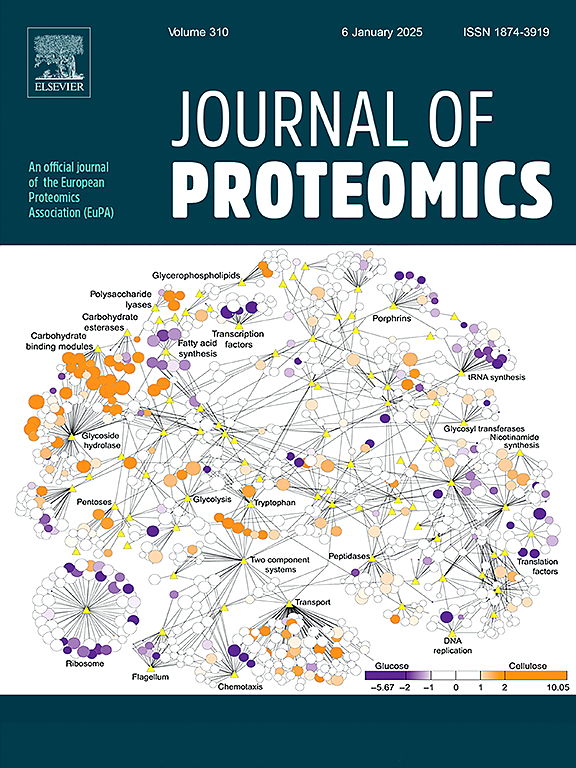利用中国胸猴蛋白质组学研究环节动物体内磷酸盐的生物矿化
IF 2.8
2区 生物学
Q2 BIOCHEMICAL RESEARCH METHODS
引用次数: 0
摘要
具有磷酸盐硬组织的生物对生命进化史和全球生物地球化学循环都有贡献。链齿动物是一种重要的磷酸盐矿化生物,以其独特的无定形磷酸盐腹尾盾而闻名。然而,其磷酸盐屏蔽形成的分子机制尚不清楚。本研究采用液相色谱-串联质谱(LC-MS/MS)技术,对中国Sternaspis chinensis(硬屏蔽组SC)和中国Sternaspis liui syn(软屏蔽组SL)的屏蔽基质蛋白(ShiMPs)进行了鉴定。共鉴定出1360个ShiMPs,其中237个在两种形态之间存在差异表达蛋白。胶原蛋白、具有新的EGF-VWA结构域的细胞外基质蛋白和钙结合蛋白在不同形态屏蔽中的差异表达表明,它们可能与屏蔽表型的变化有关。此外,发现SL组的酚氧化酶先天免疫级联通路上调。与其他生物矿物蛋白相比,胸骨骨护盾缺乏典型的几丁质相关蛋白,但富含含有EGF结构域的胶原蛋白,提示胶原蛋白可能作为无定形磷酸盐沉积的支架。本研究为胸骨护盾的形成提供了分子数据集,揭示了不同护盾形态的分子调控特征。磷酸盐是无脊椎动物体内重要的生物矿物质之一。然而,其在这些生物中形成的分子机制仍然知之甚少,并且尚未有研究探索环节动物中的磷酸盐生物矿化。在这项研究中,我们对环节动物Sternaspidae的磷酸盐屏蔽基质蛋白进行了蛋白质组学分析,为该群体的磷酸盐生物矿化提供了新的见解。通过对不同形态盾构中基质蛋白的比较分析,揭示了胶原蛋白、细胞外基质蛋白、钙结合蛋白和免疫相关蛋白的调控作用。通过与其他生物矿物的比较,我们提出胶原蛋白可以作为胸骨骨护盾中无定形磷酸盐沉积的支架。本研究促进了我们对环节动物中磷酸盐生物矿化的认识,为进一步研究无脊椎动物中磷酸盐生物矿化的形成机制奠定了基础。本文章由计算机程序翻译,如有差异,请以英文原文为准。

Proteomics of Sternaspis chinensis to understand phosphate biomineralization in annelids
Organisms with phosphate hard tissues contribute to the evolutionary history of life and global biogeochemical cycles. The annelid Sternaspidae is an important group of phosphate-mineralizing organisms, known for its unique amorphous phosphate ventro-caudal shield. However, the molecular mechanisms underlying the formation of their phosphate shields remain unclear. In this study, we identified shield matrix proteins (ShiMPs) from Sternaspis chinensis (SC group with hard shield) and Sternaspis liui syn (SL group with soft shield) using liquid chromatography-tandem mass spectrometry (LC-MS/MS). A total of 1360 ShiMPs were identified, with 237 differentially expressed proteins between the two morphologies. The differential expression of collagen, extracellular matrix proteins with new EGF-VWA domains, and calcium-binding proteins in different morphological shields suggested that they may be associated with the variation in shield phenotypes. Furthermore, the phenoloxidase innate immune cascade pathway was found to be upregulated in the SL group. Compared with other biomineral proteins, sternaspid shields lacked typical chitin-related proteins but were rich in collagen proteins containing EGF domains, suggesting that collagen may serve as a scaffold for amorphous phosphate deposition. This study provided a molecular dataset for the formation of sternaspid shields and revealed the molecular regulatory features of different shield morphologies.
Significance
Phosphate is one of the important types of biominerals in invertebrates. However, the molecular mechanisms underlying its formation in these organisms remain poorly understood, and no studies have yet explored phosphate biomineralization in annelids. In this study, we performed proteomic analysis of matrix proteins in the phosphate shields of the annelid Sternaspidae to provide new insights into phosphate biomineralization in this group. Comparative analysis of the matrix proteins in different morphological shields from Sternaspis chinensis revealed the regulation of collagen, extracellular matrix proteins, calcium-binding proteins, and immune-related proteins. By comparing with other biominerals, we proposed that collagen may serve as a scaffold for amorphous phosphate deposition in sternaspid shields. This study advances our understanding of phosphate biomineralization in annelids and provides a foundation for future research on the formation mechanisms of phosphate biominerals in invertebrates.
求助全文
通过发布文献求助,成功后即可免费获取论文全文。
去求助
来源期刊

Journal of proteomics
生物-生化研究方法
CiteScore
7.10
自引率
3.00%
发文量
227
审稿时长
73 days
期刊介绍:
Journal of Proteomics is aimed at protein scientists and analytical chemists in the field of proteomics, biomarker discovery, protein analytics, plant proteomics, microbial and animal proteomics, human studies, tissue imaging by mass spectrometry, non-conventional and non-model organism proteomics, and protein bioinformatics. The journal welcomes papers in new and upcoming areas such as metabolomics, genomics, systems biology, toxicogenomics, pharmacoproteomics.
Journal of Proteomics unifies both fundamental scientists and clinicians, and includes translational research. Suggestions for reviews, webinars and thematic issues are welcome.
 求助内容:
求助内容: 应助结果提醒方式:
应助结果提醒方式:


